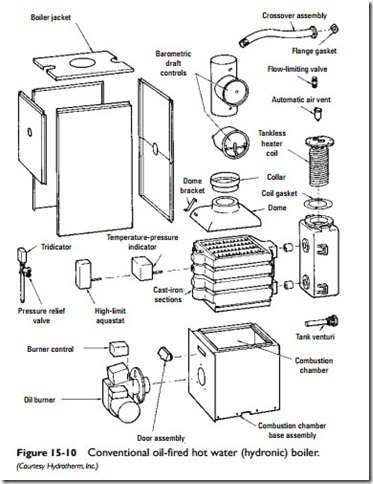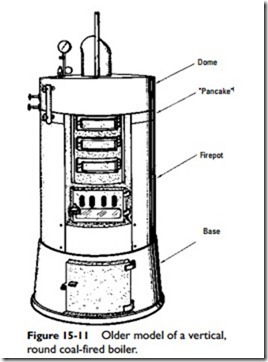Gas-Fired Boilers
Gas-fired boilers generally consist of several closely placed cast-iron sections or steel tubes with a series of gas burners (i.e., a gas burner assembly) placed beneath them. The flue gases pass upward between the sections or tubes to the flue collector.
Draft losses are kept low in these boilers because the pressure at which the gas is supplied is generally sufficient to draw in the amount of air necessary for combustion. The fact that there is no fuel-bed resistance, as there is with coal-fired boilers, also con- tributes to low draft loss.
The draft in gas-fired boilers is generally nullified by the diverter; consequently, the resistance offered by the boiler passages is not an important variable. When there is a problem of excessive draft, it can be controlled by installing a sheet-metal baffle in the flue connection at the boiler [see Control Excessive Draft (Gas-Fired Boilers) in this chapter].
Most of the controls and accessories used to operate gas-fired boilers are described in considerable detail in Chapter 2, “Gas Burners”; Chapter 5, “Gas and Oil Controls”; and Chapter 6, “Other Automatic Controls” of Volume 2. The exact placement of these controls and accessories on the steel boiler jacket may differ slightly from one manufacturer to another, but not significantly. The major difference will be in the types of controls and accessories used to govern the temperature, pressure, and of the heat-conveying medium; and this is determined by whether it is a steam or hot- water space heating boiler (see Steam Boiler Valves, Controls, and Accessories and Hot-Water Boiler Valves, Controls, and Accessories in this chapter). An exploded view of a conventional gas-fired hot-water (hydronic) boiler is shown in Figure 15-9.
OilFired Boilers
An oil-fired boiler contains a heat transfer surface consisting of either cast-iron sections or steel tubes and a special combustion chamber shaped to meet the requirements of an oil burner.
The oil burner is a device designed to mix fuel oil with air under controlled conditions and to deliver the mixture to the combustion chamber for burning. The burner is mounted outside the chamber. The oil burners used in residential heating boilers are usually high- pressure atomizing burners, although other types are used on occasion.
It is possible to convert a coal-fired boiler to oil by redesigning the combustion chamber. However, boilers specifically designed to use oil as a fuel have proven to be more efficient and economical than coal-fired boilers converted to oil.
Read Chapter 1, “Oil Burners”; Chapter 5, “Gas and Oil Controls”; and Chapter 6, “Other Automatic Controls” in Volume 2 for a description of the controls and accessories used to operate oil-fired boilers. Also read the appropriate sections in this chapter (Steam Boiler Valves, Controls, and Accessories and Hot-Water Boiler Valves, Controls, and Accessories). An exploded view of a conventional oil-fired boiler is is shown in (Figure 15-10).
Coal-Fired Boilers
A typical coal-fired boiler contains a grate for the fuel bed, located beneath metal heat transfer surfaces such as cast-iron sections (Figure 15-11). The mixture of hot gases resulting from combustion
rises through the passages in the sections, transferring its heat to the water contained in them.
The controls and accessories used to operate a coal-fired boiler are described in Chapter 3, “Coal Firing Methods” of Volume 2. The controls and accessories used to govern the temperature, pres- sure, and flow rate of the heat-conveying medium are described in
this chapter (see Steam Boiler Valves, Controls, and Accessories and Hot-Water Boiler Valves, Controls, and Accessories).
A coal-fired boiler requires more draft than gas- or oil-fired boil- ers because of the resistance of the fuel bed. Special care must be given to the design of the chamber surrounding the grate to ensure
sufficient volume for a proper mixture of fuel and air. Provisions must also be made for introducing sufficient air through the grate (and fuel bed) for the combustion process.
Before the introduction of oil burners, coal was the fuel in general use, and it is still largely used, especially for heating plants already built and in cases where the owner cannot afford the expense of converting to oil. Moreover, some cast-iron boilers designed to burn coal are not suited to burn oil, which adds to the expense of a conversion job. Finally, the increasing worldwide shortage of oil will find it more and more necessary to find applications for low-polluting uses of coal as a heat source. An important use for coal will be steam and hot-water heating systems equipped with devices to reduce the polluting effect of burning coal.
Coal-burning boilers may be hand-fired or fitted for automatic stoker operation. In many automatic stokers, fuel is carried from the hopper through a feed tube by means of a rotating worm. Intermittent action of the worm agitates the fuel bed, prevents arch- ing of the coal in the retort, and ensures that the incoming air reaches every part of the fire at all times. An auxiliary air connec- tion between the feed tube and the windbox prevents gas accumu- lating in the tube and eliminates any tendency to “smoke back” through the hopper.
An underfeed stoker is one in which the fuel is fed upward from underneath. The action of a screw or worm carries the fuel back through a retort, from which it passes upward as the fuel is con- sumed, the ash being finally deposited on dead plates on either side of the retort, from which it can be removed.
Only part of the fuel being burned is actually burned in the fuel bed. Under the influence of the high temperature created in the fuel bed and lack of sufficient air, unburned gases are released above the retort and tuyeres; and unless these gases are mixed with air and burned inside the combustion chamber, they will leave the boiler unburned, carrying away a large percentage of the heat energy value originally contained in the coal.
Nearer the outside of the fuel bed, the fuel burns less violently, and much more air is passed through the fuel bed than is necessary. It is this excess air that must be mixed with the unburned gases issuing from the central point of the fuel bed if high combustion efficiency is to be realized.
Coke can also be used to fire boilers, but it requires different handling. In order to be completely consumed, coke needs a greater volume of air per pound of fuel than coal and therefore requires a stronger draft, which is increased by the fact that it can burn economically only in a thick bed.
Because less coke is burned per hour per square foot of grate than coal, a larger grate and a deep firepot are required to accommodate the thick bed of coke.
The quick-flaming combustion that characterizes coal is not produced by coke because the latter fuel contains very little hydrogen; however, a coke fire is more even and regular.


